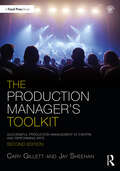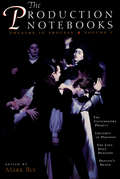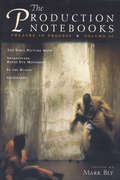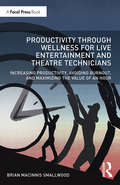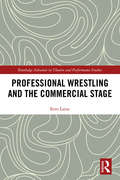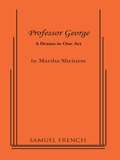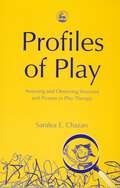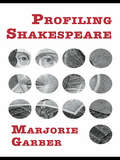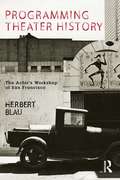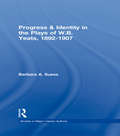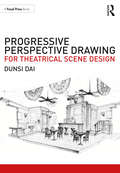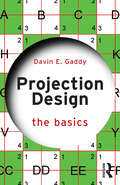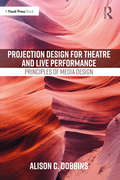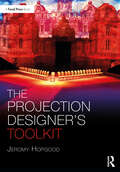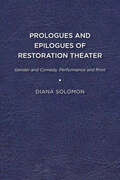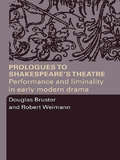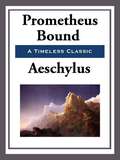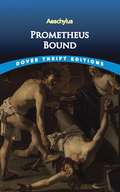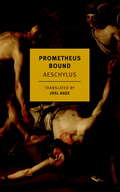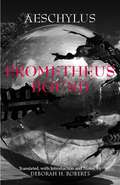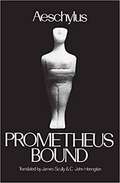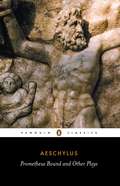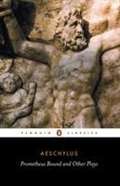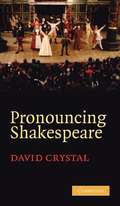- Table View
- List View
The Production Manager's Toolkit: Successful Production Management in Theatre and Performing Arts (The Focal Press Toolkit Series)
by Cary Gillett Jay SheehanThe Production Manager’s Toolkit Second Edition offers an up-to-date, comprehensive introduction to a theatrical and special event production career for new and aspiring professionals, given by expert voices in the field. The book discusses management techniques, communication skills, and relationship building tactics to become effective and successful production managers. With a focus on management theory, top production managers provide insights into budgeting, scheduling, meetings, hiring, maintaining safety, and more. Through interviews and case studies, production management techniques are explored throughout various entertainment genres including theatre, dance, opera, music, and special events. The second edition includes all new case studies, new chapters, and updated content throughout, showcasing a continued progressive approach to the job and the field. Filled with references, tools, templates, and checklists, The Production Manager’s Toolkit is an invaluable resource for students of Production Management, Events Management, and Stage Management courses, as well as new and aspiring professionals. The book includes access to a companion website featuring downloadable paperwork and links to other useful resources such as unions, venues, and vendors. (www.routledge.com/cw/gillett)
The Production Notebooks
by Mark BlyFirst in a series of casebooks exploring theatrical pieces from writing and design through production. Includes: Ntozake Shange's The Love Space Demands, Crossroads Theatre Co., New Brunswick, NJ; Danton's Death by Buchner, Alley Theatre, Houston; The Clytemnestra Project, based on the works of Aeschylus, Sophocles, and Euripides, Guthrie Theatre, Minneapolis; and Children of Paradise, Theatre de la Jeune Lune, Minneapolis.
The Production Notebooks, Volume 2
by Mark BlyThe second volume in the series provides an inside view of the creative process involved in the creation of 4 major theatrical productions. Each notebook offers in diary form comprehensive histories of major artistic elements that are the center of the creative process. This volume includes: In the Blood by Suzan-Lori Parks (The Joseph Papp Public Theatre/New York Shakespeare Festival); The First Picture Show by David and Ain Gordon (Mark Taper Forum and American Conservatory Theatre), The Geography Project by Ralph Lemon (Yale Repertory Theatre) and Shakespeare Rapid Eye Movement, directed by Robert Lepage (Bayerisches Staatsschauspiel-Munich). Each notebook is profusely illustrated with production shots and/or set and costume renderings.Mark Bly is the Associate Artistic Director of the Yale Repertory Theatre.
Productivity Through Wellness for Live Entertainment and Theatre Technicians: Increasing Productivity, Avoiding Burnout, and Maximizing the Value of An Hour
by Brian MacInnis SmallwoodProductivity Through Wellness for Live Entertainment and Theatre Technicians provides the tools for individuals and organizations to achieve a healthy work–life balance and increase productivity in the production process of live entertainment. Through examination of the limits of the human body, the fundamentals of motivation, and best practices of project management, the reader will develop operational mindfulness and look at new ways to achieve work–life balance. The book explores case studies that show how organizations are promoting work–life balance and reaping the benefits of increased productivity, makes recommendations to reduce burnout and increase productivity among technicians, and discusses how to deal with the various phases of production. An excellent resource for live entertainment technicians, production managers, technical directors, arts managers, managers in live entertainment, and students in Technical Direction and Production Management courses, Productivity Through Wellness for Live Entertainment and Theatre Technicians offers practical solutions to improve the quality of life of employees, reduce the burnout and injuries of overwork, and maximize the value of an hour.
Professing Performance
by Shannon JacksonToday's academic discourse is filled with the word 'perform'. Nestled amongst a variety of prefixes and suffixes (re-, post-, -ance, -ivity?), the term functions as a vehicle for a host of contemporary inquiries. For students, artists, and scholars of performance and theatre, this development is intriguing and complex. By examining the history of theatre studies and related institutions and by comparing the very different disciplinary interpretations and developments that led to this engagement, Professing Performance offers ways of placing performance theory and performance studies in context. This 2004 book considers the connection amongst a range of performance forms such as oratory, theatre, dance, and performance art and explores performance as both a humanistic and technical field of education. Throughout, she explores the institutional history of performance in the US academy in order to revise current debates around the role of the arts and humanities in higher education.
Professional Wrestling and the Commercial Stage (Routledge Advances in Theatre & Performance Studies)
by Eero LaineProfessional Wrestling and the Commercial Stage examines professional wrestling as a century-old, theatrical form that spans from its local places of performance to circulate as a popular, global product. Professional wrestling has all the trappings of sport, but is, at its core, a theatrical event. This book acknowledges that professional wrestling shares many theatrical elements such as plot, character, scenic design, props, and spectacle. By assessing professional wrestling as a neglected but prototypical case study in the global business of theatre, Laine argues that it is an exemplary form of globalizing, commercial theatre. He asks what theatre scholars might learn from pro wrestling and how pro wrestling might contribute to conversations beyond the ring, by considering the laboring bodies of the wrestlers, and analyzing wrestling’s form and content. Of interest to scholars and students of theatre and performance, cultural studies, and sports studies, Professional Wrestling and the Commercial Stage delimits the edges of wrestling’s theatrical frame, critiques established understandings of corporate theatre, and offers key wrestling concepts as models for future study in other fields.
Professor George
by Marsha SheinessWhat seems to be an ordinary situation is turned inside out to provide a fascinating, near bizarre experience. Five college students are confronted with "unheard of" demands and challenges from Professor George who'll try almost anything to free students from habits limiting a person's potential. The professor shows a twig to them and says. "There's someone in the twig waiting for us to find him or her." Later, it's understood the search for the twig's symbolic person is really the search for the unique in each individual.
Profiles of Play: Assessing and Observing Structure and Process in Play Therapy
by Saralea ChazanWritten by a leading child psychologist, this clearly written and practical book provides a template for interpreting change and meaning in children's lives through their play activity. It shows how each child's pattern of play has a distinct profile of measurable features. These can be identified - and can be used to assess the child's development. The processes of change that a child goes through and the different kinds of play profiles are clearly illustrated with examples from real life. This will be a useful resource for all professionals who work with children and are looking to support their development through a deeper understanding of their inner experiences, including family therapists, educational psychologists, special needs teachers, play therapists and child care social workers.
Profiling Shakespeare
by Marjorie GarberThe title of this collection, Profiling Shakespeare, is meant strongly in its double sense. These essays show the outline of a Shakespeare rather different from the man sought by biographers from his time to our own. They also show the effects, the ephemera, the clues and cues, welcome and unwelcome, out of which Shakespeare's admirers and dedicated scholars have pieced together a vision of the playwright, whether as sage, psychologist, lover, theatrical entrepreneur, or moral authority. This collection brings together classic pieces, hard-to-find chapters, and two new essays. Here, Garber has produced a book at once serious and highly readable, ranging broadly across time periods (early modern to postmodern) and touching upon both high and popular culture. Contents: Preface 1. Shakespeare's Ghost Writers 2. Hamlet: Giving Up the Ghost 3. Macbeth: The Male Medusa 4. Shakespeare as Fetish 5. Character Assassination 6. Out of Joint 7. Roman Numerals 8. Second-Best Bed 9. Shakespeare's Dogs 10. Shakespeare's Laundry List 11. Shakespeare's Faces 12. MacGuffin Shakespeare 13. Fatal Cleopatra 14. What Did Shakespeare Invent? 15. Bartlett's Familiar Shakespeare
Programming Theater History: The Actor's Workshop of San Francisco
by Herbert Blau‘One of the great stories of the American theater..., the Workshop not only built an international reputation with its daring choice of plays and nontraditional productions, it also helped launch a movement of regional, or resident, companies that would change forever how Americans thought about and consumed theater.’ – Elin Diamond, from the Introduction Herbert Blau founded, with Jules Irving, the legendary Actor's Workshop of San Francisco, in 1952, starting with ten people in a loft above a judo academy. Over the course of the next 13 years and its hundred or so productions, it introduced American audiences to plays by Brecht, Beckett, Pinter, Genet, Arden, Fornes, and various unknown others. Most of the productions were accompanied by a stunningly concise and often provocative programme note by Blau. These documents now comprise, within their compelling perspective, a critique of the modern theatre. They vividly reveal what these now canonical works could mean, first time round, and in the context of 1950s and 60s American culture, in the shadow of the Cold War. Programming Theater History curates these notes, with a selection of the Workshop's incrementally artful, alluring programme covers, Blau's recollections, and evocative production photographs, into a narrative of indispensable artefacts and observations. The result is an inspiring testimony by a giant of American performance theory and practice, and a unique reflection of what it is to create theatre history in the present.
Progress & Identity in the Plays of W.B. Yeats, 1892-1907 (Studies in Major Literary Authors #25)
by Barbara A. SuessFirst Published in 2003. Routledge is an imprint of Taylor & Francis, an informa company.
Progressive Perspective Drawing for Theatrical Scene Design
by Dunsi DaiProgressive Perspective Drawing for Theatrical Scene Design provides theatrical scenic designers with the tools to create quick and precise perspective drawings. The book explores three methods of perspective drawings at progressive skill levels – the Grid Method, the Frame Method, and the Freehand with References Method – allowing scenic designers to build on their drawing technique consistently. Replete with discussions on pencil techniques, step by step instructions, and set sketches from professional set design projects, this volume guides readers from the basics of the cube system to the more challenging freehand drawing. Progressive Perspective Drawing for Theatrical Scene Design is an excellent resource for students of Scene Design, Stage Design, Set Design, Scenography, Stagecraft, and Design for Theatre, as well as an accessible self-study guide for those with an interest in scene design. The book includes access to downloadable pre-made perspective grids, to help readers familiarize themselves with one and two vanishing point grids.
Projection Design: The Basics (The Basics)
by Davin E. GaddyProjection Design: The Basics explores the concepts of visual elements in live entertainment. It provides a conversational view of the fundamentals of projection design, from production meetings and the elements of visual design to the equipment necessary to make it all happen.This text examines the themes and theories universal to a wide range of topics, to provide a foundation for anyone interested in using video for their live production or those who are looking where to start as a designer. Topics covered include: Methods of extracting visuals from a script and communicating them to production staff Basics of visual design Understanding human perception and how this influences design How to choose the right equipment to build a system With a detailed glossary, basic formulas, and comprehensive explanation from start to finish, Projection Design: The Basics is an ideal primer for Projection Design courses, and will be of interest to anyone entering the field of projection and media design for the first time.
Projection Design for Theatre and Live Performance: Principles of Media Design
by Alison C. DobbinsProjection Design for Theatre and Live Performance explores the design and creation process of projections from a non-technical perspective, examining the principles of media for the stage in a manner that is accessible for both beginning designers and advanced designers dabbling in projections for the first time. This introductory text covers concepts and tools for designing, techniques to help readers tap into their creativity, and the core skills required of this field: problem solving, project management, and effective communication. Focusing exclusively on design and creativity, this book encourages individuals to leap into the creative design process before facing any perceived hurdles of learning everything technical about media delivery systems, cueing systems, projectors, cables, computer graphics, animation, and video production. Projection Design for Theatre and Live Performance is a reminder that, from the invention of photography to the enormous variety of electronic media that exist today, the ways projection designers can enhance a theatrical production are limitless. Written in an accessible style, this book is a valuable resource for students of Projection Design as well as emerging professionals. Its focus on design and creativity will restore the confidence of individuals who may have been daunted by technical hurdles and will encourage the creativity of those who may have been disappointed with their efforts in this field of design in the past.
The Projection Designer’s Toolkit (The Focal Press Toolkit Series)
by Jeromy HopgoodThe Projection Designer’s Toolkit is an insider’s guide to the world of professional projection design, serving as a reference for the planning and execution of each step in the projection design process. The text addresses the design process within the context of a professional projection designer’s workflow, focusing on specific tools of the trade, best practices for communicating your design to collaborators, tips and tricks, determining budget, working with assistants, and more. Featuring interviews with some of the top names in the industry, the book offers an unprecedented insight into the professional projection designer’s process across a wide range of fields, from Broadway and regional theatre to corporate design and music touring. The book also includes in-depth discussion on production process, system design, cue and content planning, content design, digital media fundamentals, media servers, video equipment, and projection surfaces. Additionally, it features hundreds of full-color photos and examples of designer artifacts such as draftings, mock-ups, paperwork, cue sheets, and renderings. Filled with practical advice that will guide readers from landing their first job all the way through opening night and beyond, The Projection Designer’s Toolkit is the perfect resource for emerging projection designers and students in Digital Media Design and Projection Design courses.
Prologues and Epilogues of Restoration Theater: Gender and Comedy, Performance and Print
by Diana SolomonOften perceived as merely formulaic or historical documents, dramatic prologues and epilogues – players’ comic, poetic bids for the audience’s good opinion – became essential parts of Restoration theater, appearing in over 90 percent of performed and printed plays between 1660 and 1714. Their popularity coincided with the rise of the English actress, and Prologues and Epilogues of Restoration Theater unites these elements in the first book-length study on the subject. It finds that these paratexts provided the first sanctioned space for actresses in Britain to voice ideas in public, communicate directly with other women, and perform comedy – arguably the most powerful type of speech, and one that enabled interrogation of misogynist social practices. This book provides a taxonomy of prologues and epilogues with a corresponding appendix, and demonstrates through case studies of Anne Bracegirdle and Anne Oldfield how the study of prologues and epilogues enriches Restoration theater scholarship. Published by University of Delaware Press. Distributed worldwide by Rutgers University Press.
Prologues to Shakespeare's Theatre: Performance and Liminality in Early Modern Drama
by Douglas Bruster Robert WeimannThis eye-opening study draws attention to the largely neglected form of the early modern prologue. Reading the prologue in performed as well as printed contexts, Douglas Bruster and Robert Weimann take us beyond concepts of stability and autonomy in dramatic beginnings to reveal the crucial cultural functions performed by the prologue in Elizabethan England.While its most basic task is to seize the attention of a noisy audience, the prologue's more significant threshold position is used to usher spectators and actors through a rite of passage. Engaging competing claims, expectations and offerings, the prologue introduces, authorizes and, critically, straddles the worlds of the actual theatrical event and the 'counterfeit' world on stage. In this way, prologues occupy a unique and powerful position between two orders of cultural practice and perception.Close readings of prologues by Shakespeare and his contemporaries, including Marlowe, Peele and Lyly, demonstrate the prologue's role in representing both the world in the play and playing in the world. Through their detailed examination of this remarkable form and its functions, the authors provide a fascinating perspective on early modern drama, a perspective that enriches our knowledge of the plays' socio-cultural context and their mode of theatrical address and action.
Prometheus Bound
by AeschylusAeschylus based his epic drama on the legendary tale of Prometheus, the Titan who stole fire from the gods for the benefit of humanity. Prometheus's terrible punishment remains a universal symbol of human vulnerability in any struggle with the gods, and this ancient play continues to entrance audiences with its timeless appeal.
Prometheus Bound: Translated From The Greek (classic Reprint) (Dover Thrift Editions)
by AeschylusIn Greek legend, Prometheus was the Titan who, against the will of Zeus, stole fire from the gods for the benefit of man. His terrible punishment by Zeus, and his continuing defiance of Zeus in the face of that punishment, remain universal symbols of man's vulnerability in any struggle with the gods.In the epic drama Prometheus Bound, Aeschylus (c. 525-456 BC), first of the three great Greek tragic poets, re-creates this legendary conflict between rebellious subject and vengeful god. Chained for eternity to a barren rock, his flesh repeatedly torn by a ravaging eagle, Prometheus defends his championship of mankind, rejoicing in the many gifts of language and learning he has given man despite Zeus's cruel opposition.Inspired by Prometheus's spirit, Aeschylus reaches beyond the myth to create one of literature's most gripping portrayals of man's inhumanity to man. How Prometheus clings to his convictions and braves his harsh fate give Prometheus Bound its extraordinary vitality and appeal. For over 2,000 years, this masterpiece of drama has held audiences enthralled. It is reprinted here in its entirety from the translation by George Thomson.
Prometheus Bound
by Aeschylus Joel AgeePrometheus Bound is the starkest and strangest of the classic Greek tragedies, a play in which god and man are presented as radically, irreconcilably at odds. It begins with the shock of hammer blows as the Titan Prometheus is shackled to a rock in the Caucasus. This is his punishment for giving the gift of fire to humankind and for thwarting Zeus's decision to exterminate the human race. Prometheus's pain is unceasing, but he refuses to recant his commitment to humanity, to whom he has also brought the knowledge of writing, mathematics, medicine, and architecture. He hints that he knows how Zeus will be brought low in the future, but when Hermes demands that Prometheus divulge his secret, he refuses and is sent spinning into the abyss by a divine thunderbolt. To whom does humanity look for guidance: to the supreme deity or to the rebel Titan? What law controls the cosmos? Prometheus Bound, one of the great poetic achievements of the ancient world, appears here in a splendid new translation by Joel Agee that does full justice to the harsh and keening music of the original Greek.
Prometheus Bound
by Aeschylus Deborah RobertsThis is an outstandingly useful edition of Prometheus Bound. The translation is both faithful and graceful, and the introduction to this difficult play is a model of clarity, intelligence, and a profound familiarity with the workings of Greek myth, Greek literature, and literature in general. --Rachel Hadas, Department of English, Rutgers University
Prometheus Bound (Greek Tragedy In New Translations)
by Aeschylus James Scully C. John HeringtonFor readers accustomed to the relatively undramatic standard translations ofPrometheus Bound, this version by James Scully, a poet and winner of the Lamont Poetry Prize, and C. John Herington, one of the world's foremost Aeschylean scholars, will come as a revelation. Scully and Herington accentuate the play's true power, drama, and relevance to modern times. Aeschylus originally wrotePrometheus Boundas part of a tragic trilogy, and this translation is unique in including the extant fragments of the companion plays.
Prometheus Bound and Other Plays: The Persians / Prometheus Bound / Seven Against Thebes / The Suppliants (The\complete Greek Tragedies Ser.)
by AeschylusAeschylus (525–456 BC) brought a new grandeur and epic sweep to the drama of classical Athens, raising it to the status of high art. In Prometheus Bound the defiant Titan Prometheus is brutally punished by Zeus for daring to improve the state of wretchedness and servitude in which mankind is kept. The Suppliants tells the story of the fifty daughters of Danaus who must flee to escape enforced marriages, while Seven Against Thebes shows the inexorable downfall of the last members of the cursed family of Oedipus. And The Persians, the only Greek tragedy to deal with events from recent Athenian history, depicts the aftermath of the defeat of Persia in the battle of Salamis, with a sympathetic portrayal of its disgraced King Xerxes.Philip Vellacott’s evocative translation is accompanied by an introduction, with individual discussions of the plays, and their sources in history and mythology.
Prometheus Bound And Other Plays
by Aeschylus Philip Vellacott (Introduction by TranslatorAeschylus (525-456 BC) brought a new grandeur and epic sweep to the drama of classical Athens, raising it to the status of high art. In Prometheus Bound,the defiant Titan Prometheus is brutally punished by Zeus for daring to improve the state of wretchedness and servitude in which mankind is kept. The Suppliantstells the story of the fifty daughters of Danaus who must flee to escape enforced marriages, while Seven Against Thebesshows the inexorable downfall of the last members of the cursed family of Oedipus. And The Persians,the only Greek tragedy to deal with events from recent Athenian history, depicts the aftermath of the defeat of Persia in the battle of Salamis, with a sympathetic portrayal of its disgraced King Xerxes. Philip Vellacott's evocative translation is accompanied by an introduction, with individual discussions of the plays, and their sources in history and mythology.
Pronouncing Shakespeare: The Globe Experiment
by David CrystalIn an unusual blend of autobiography, narrative, and academic content, reflecting the unique nature of the experience, David Crystal recounts the first attempt in over 50 years to mount a full-length Shakespeare play in original pronunciation.
